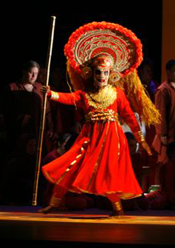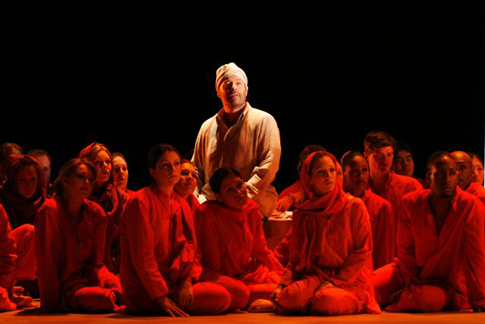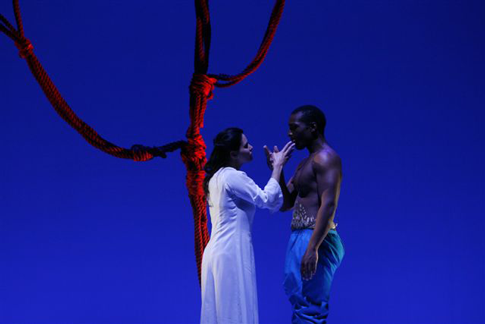![Kumudha (Natasha Jouhl) transforms into a flowering tree [Photo by Liz Lauren]](http://www.operatoday.com/a-flowering-tree.png)
28 May 2008
Tree-mendous in Chicago
Chicago Opera Theater scored a resounding success with its area premiere of John Adams’ newest stage piece, “A Flowering Tree.”
English Touring Opera are delighted to announce a season of lyric monodramas to tour nationally from October to December. The season features music for solo singer and piano by Argento, Britten, Tippett and Shostakovich with a bold and inventive approach to making opera during social distancing.
This tenth of ten Live from London concerts was in fact a recorded live performance from California. It was no less enjoyable for that, and it was also uplifting to learn that this wasn’t in fact the ‘last’ LfL event that we will be able to enjoy, courtesy of VOCES8 and their fellow vocal ensembles (more below …).
Ever since Wigmore Hall announced their superb series of autumn concerts, all streamed live and available free of charge, I’d been looking forward to this song recital by Ian Bostridge and Imogen Cooper.
Although Stile Antico’s programme article for their Live from London recital introduced their selection from the many treasures of the English Renaissance in the context of the theological debates and upheavals of the Tudor and Elizabethan years, their performance was more evocative of private chamber music than of public liturgy.
Evidently, face masks don’t stifle appreciative “Bravo!”s. And, reducing audience numbers doesn’t lower the volume of such acclamations. For, the audience at Wigmore Hall gave soprano Elizabeth Llewellyn and pianist Simon Lepper a greatly deserved warm reception and hearty response following this lunchtime recital of late-Romantic song.
For this week’s Live from London vocal recital we moved from the home of VOCES8, St Anne and St Agnes in the City of London, to Kings Place, where The Sixteen - who have been associate artists at the venue for some time - presented a programme of music and words bound together by the theme of ‘reflection’.
'Such is your divine Disposation that both you excellently understand, and royally entertaine the Exercise of Musicke.’
‘And there was war in heaven: Michael and his angels fought against the dragon; and the dragon fought and his angels, And prevailed not; neither was their place found any more in heaven … that old serpent … Satan, which deceiveth the whole world: he was cast out into the earth, and his angels were cast out with him.’
There was never any doubt that the fifth of the twelve Met Stars Live in Concert broadcasts was going to be a palpably intense and vivid event, as well as a musically stunning and theatrically enervating experience.
‘Love’ was the theme for this Live from London performance by Apollo5. Given the complexity and diversity of that human emotion, and Apollo5’s reputation for versatility and diverse repertoire, ranging from Renaissance choral music to jazz, from contemporary classical works to popular song, it was no surprise that their programme spanned 500 years and several musical styles.
The Academy of St Martin in the Fields have titled their autumn series of eight concerts - which are taking place at 5pm and 7.30pm on two Saturdays each month at their home venue in Trafalgar Square, and being filmed for streaming the following Thursday - ‘re:connect’.
The London Symphony Orchestra opened their Autumn 2020 season with a homage to Oliver Knussen, who died at the age of 66 in July 2018. The programme traced a national musical lineage through the twentieth century, from Britten to Knussen, on to Mark-Anthony Turnage, and entwining the LSO and Rattle too.
With the Live from London digital vocal festival entering the second half of the series, the festival’s host, VOCES8, returned to their home at St Annes and St Agnes in the City of London to present a sequence of ‘Choral Dances’ - vocal music inspired by dance, embracing diverse genres from the Renaissance madrigal to swing jazz.
Just a few unison string wriggles from the opening of Mozart’s overture to Le nozze di Figaro are enough to make any opera-lover perch on the edge of their seat, in excited anticipation of the drama in music to come, so there could be no other curtain-raiser for this Gala Concert at the Royal Opera House, the latest instalment from ‘their House’ to ‘our houses’.
"Before the ending of the day, creator of all things, we pray that, with your accustomed mercy, you may watch over us."
The doors at The Metropolitan Opera will not open to live audiences until 2021 at the earliest, and the likelihood of normal operatic life resuming in cities around the world looks but a distant dream at present. But, while we may not be invited from our homes into the opera house for some time yet, with its free daily screenings of past productions and its pay-per-view Met Stars Live in Concert series, the Met continues to bring opera into our homes.
Music-making at this year’s Grange Festival Opera may have fallen silent in June and July, but the country house and extensive grounds of The Grange provided an ideal setting for a weekend of twelve specially conceived ‘promenade’ performances encompassing music and dance.
There’s a “slide of harmony” and “all the bones leave your body at that moment and you collapse to the floor, it’s so extraordinary.”
“Music for a while, shall all your cares beguile.”
The hum of bees rising from myriad scented blooms; gentle strains of birdsong; the cheerful chatter of picnickers beside a still lake; decorous thwacks of leather on willow; song and music floating through the warm evening air.
![Kumudha (Natasha Jouhl) transforms into a flowering tree [Photo by Liz Lauren]](http://www.operatoday.com/a-flowering-tree.png)
Chicago Opera Theater scored a resounding success with its area premiere of John Adams’ newest stage piece, “A Flowering Tree.”
And it did so with a completely different take on the piece than that devised by Peter Sellars for Vienna’s world premiere in November 2006 at the Festival of New Crowned Hope.
The original concept had the large orchestra on stage, with minimal stage action relegated to small elevated playing spaces, more semi-staged oratorio than a full-fledged dramatic rendering. It is perhaps no accident that this Chicago company has “theater” prominently included in its name, for they have put the band back in the pit, and with consummate stagecraft, they fleshed out this folk tale’s libretto which was crafted by Sellars and the composer based on a story translated by A.K. Ramanujan from the Kannada language of southern India.
 The king (James Johnson, dancer).
The king (James Johnson, dancer).
The tale concerns two sisters, one of whom, “Kumudha,” is able to
transform herself into “A Flowering Tree” and back again. However, her
jealous sibling’s wicked friends break the spell, trapping the heroine in
her tree-state, breaking her limbs, and leaving her in the gutter as a
pitiful grub-like torso. After her disappearance, the “Prince,” having
already wedded her for her bewitching beauty and powers, wanders
disconsolately until his love restores her and reunites them in marital
bliss. The only other singing principal is a “Storyteller.”
The minimalist set and costume design by George Souglides scored big, with simple yet highly imaginative effects. The first important transformation scene was accomplished with “Kumudha’s” sister (dancer Karla Victum) stretching hidden, over-long sleeves from her costume and extending and twisting the “branches” into various shapes. Each subsequent transfiguration was larger then the previous, magically accomplished with colored ropes.
Whether descending from the flies or rising from the stage floor, these were presented in artfully tied designs that would be the envy of any advanced macrame class. Indeed, the curtain rise of Act Two stunningly coincided with a “growing tree” emanating from “Kumudha” down center stage that ultimately filled the entire proscenium opening. The few set pieces and props (a veil-covered over-sized wedding bed, a gilt throne, primitive masks on poles) were selected with attentive care.
 The Storyteller (Sanford Sylvan).
The Storyteller (Sanford Sylvan).
The evocative and colorful costume design was effectively based on
traditional Indian and Asian street and stage garb, with a couple of the
specialty dance turns being dazzlingly outfitted. I wish that same attention
had been lavished on our heroine, who looked quite plain; well, too plain by
comparison. Indeed, the rather lumpy and shapeless white coat she wore in the
wedding scene was promisingly removed to reveal only more of the same look,
if better fitted. All of this was well-served by Aaron Black’s terrific
lighting, artfully combining lustrous washes of color with well-calculated
and flawlessly executed specials, gobos, and area lighting.
If all this was gorgeous to behold, it would not have impacted us as strongly as it did without Nicola Raab’s masterful direction. First, without ever unduly cluttering the stage, Ms. Raab has devised meaningful and poetic movement for the large chorus and corps de ballet. As we entered the theatre, the white-garbed “Storyteller” was already seated, immobile on a chair stage right. Slowly, the chorus in reddish-orange filed on from various points and seated themselves on the stage around him, ultimately creating a visual “island” that captivates us before a note is played. We couldn’t wait to hear what he has to say.
Similarly, meaningful character relationships are defined with ethereal subtlety. The mating scene with our newlyweds walking/stalking on the bridal bed was a study in sensuous restraint, as the pair never quite touched but conveyed the impression of love-making nonetheless by tracing the head and torso with slow sweeping gestures, and intertwining their arms (well, almost) in ever inventive combinations.
Perhaps the most problematic scene of all, the dismemberment of the tree-trapped “Kumudha” was beautifully solved by having two dancers wrap her in a cocoon of a vibrant red cloth. Leaving one arm free, the actress could recline, sit up, and drag herself around the stage as a sympathetic outcast.
The ritualistic choreography by Renato Zanello was well-executed by not only his trained dancers, but also pleasingly performed by the singing chorus. The clean, thrilling choral work (most of them are in the COT Young Artists Program) was complemented by the group’s exceptional ability to transform themselves at will from commentators, to bystanders, to relatives, to royal subjects, all the while doing some amazing staged business, not the least of which was crawling from the wings on their bellies to pick up folded boards that were used in any number of combinations to create everything from a village of houses to a penultimate pop-up back-drop for the lovers’ reunion.
COT assembled a fine trio of singers as its principals. Natasha Jouhl proved an affecting “Kumudha,” singing with a well-schooled, ample lyric soprano that easily encompassed all the wide ranging demands and soaring lines of this difficult role. Originally written with Dawn Upshaw in mind, the part was taken over in Vienna (and several other locations) by rising star Jessica Rivera (who recently triumphed locally in another Adams piece, Chicago Lyric’s “Dr. Atomic”). Dawn and Jessica are two artists who really “get” this music and don’t just sing it, but embody it. That said, although she vocalized it splendidly, looked attractive, and acted with commitment, I did not yet feel that Ms. Jouhl has fully integrated the piece into her voice, or more particularly, her artistry. I would love to see her again after she has the experience of some more performances.
With Noah Stewart’s “Prince” I felt that we were experiencing an artist on the verge of a major career. He brought a regal bearing to the portrayal, and a polished, weighty lyric voice with excellent thrust on the high phrases, and wonderful presence throughout the range. Excellent diction, handsome good looks, beautiful instrument, wonderful musical instincts, sound technique, stage savvy — he’s got the goods.
I have long admired the fine artist Sanford Sylvan, but I found that his soft-grained approach was initially a little too lieder-based and subtle for the task at hand as the “Storyteller.” Seated a third of the way upstage for the first act, while I could hear his beautiful sounds and sensitive phrasing, I too often had real trouble understanding the text and found my gaze drifting to the surtitles. When he came forward to the side of the proscenium in Act Two, there was an immediate difference. This would be a quick fix by just telling him to “Sing out, Louise” when he is upstage. Still, he is a treasureable baritone and was an audience favorite.
 Kumudha (Natasha Jouhl) and the Prince (Noah Stewart).
Kumudha (Natasha Jouhl) and the Prince (Noah Stewart).
Diminutive Joana Carneiro had taken over conducting duties from Mr. Adams
and this was a tour-de-force assumption. “Tree” is a monster-piece that
calls for split second rhythmic changes, quicksilver mood-altering shifts,
lyrical outpouring, percussive tirades, and well, the kitchen sink just may
have been in there somewhere. Above all, this stuff must be clean-clean-clean
to make its hypnotic effect and save a few squishy moments in the opening
bars’ undulating strings, Ms. Carneiro was in full command of her forces.
As if she was driving a car at 120 miles an hour, there was no room for
error. And she negotiated every twist and turn of this challenging piece with
concentrated inspiration. Brava Maestra!
It seems as though Mr. Adams may have developed the score a bit since Vienna, where I remember thinking that perhaps the heroine should have a set piece up front to announce her character. It seems that “Kumudha” had more exposition to sing at COT. Or maybe the staging was just that much more compelling. For all its glories, and they are many and they are ravishing, I still found myself wishing that the long chanted choral dance in Act Two (sort of Rap-Lite) was a bit shorter. And I sorta wanted a radiant final duet for the reunited lovers. Have I seen “Turandot” too many times? Perhaps.
Still, this was in toto a welcome and notable achievement. Chicago is a world class musical city and with Chicago Opera Theater’s “A Flowering Tree” we have been treated to a sampling of the very best the town has to offer.
James Sohre